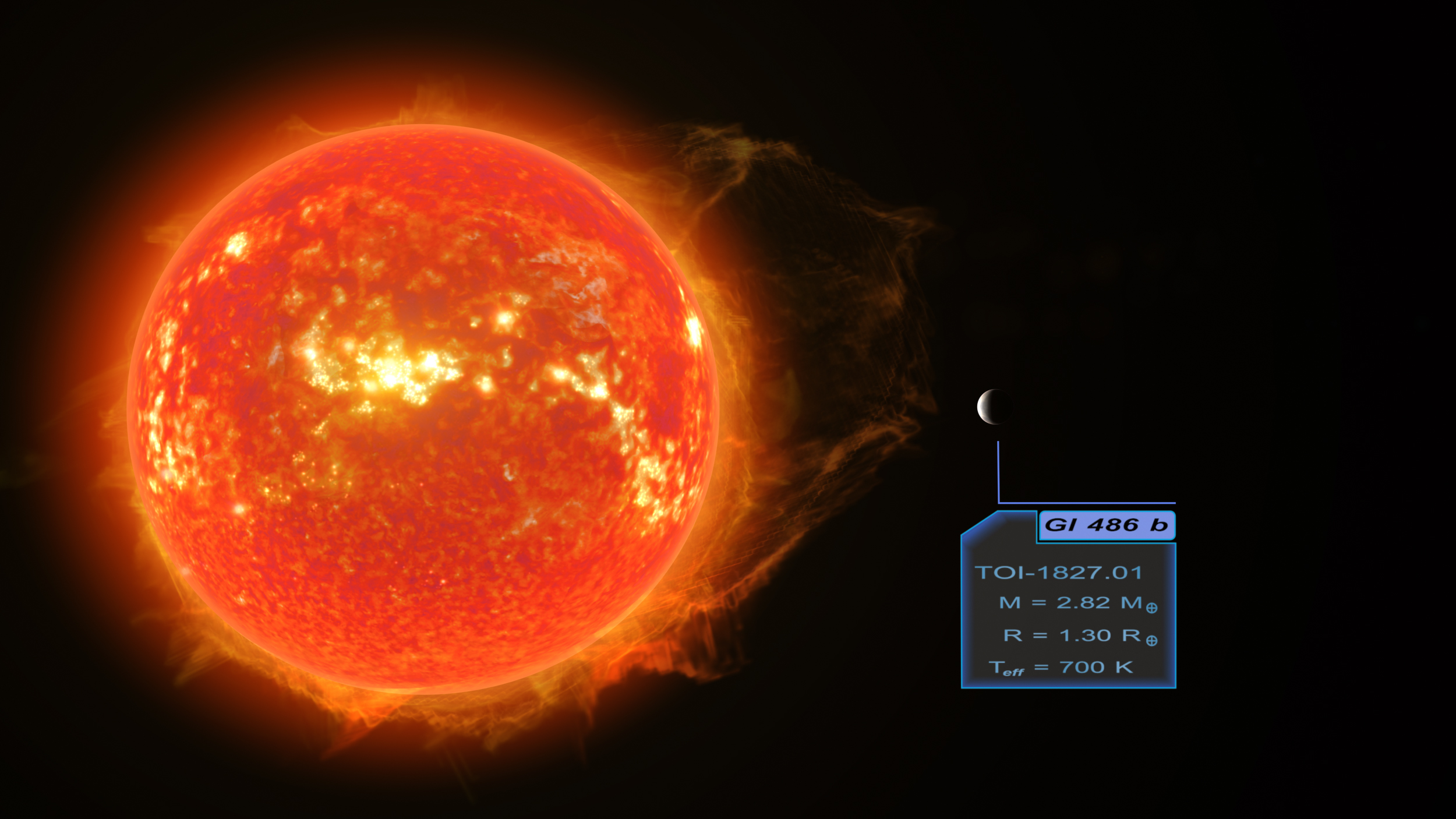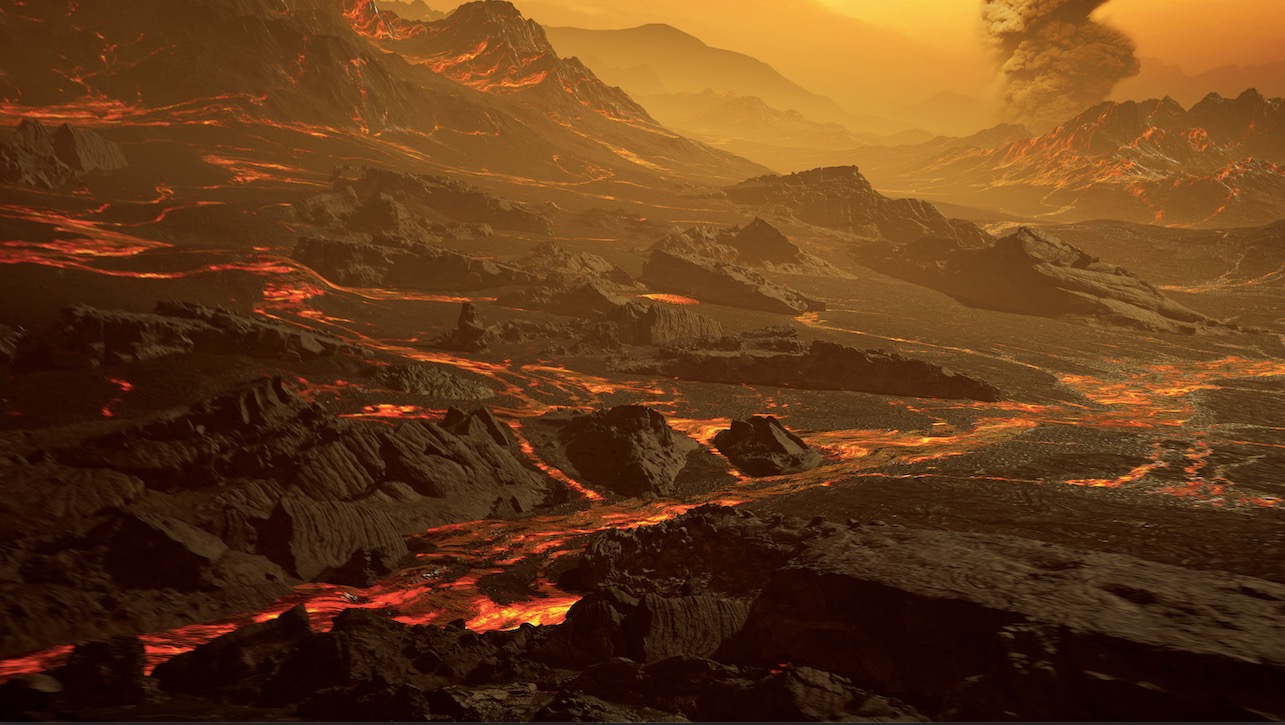
A newly discovered alien world could help astronomers better understand the atmospheres of rocky planets.
The newfound exoplanet, Gliese 486 b, circles a dim red dwarf star just 26 light-years from Earth and is about 1.3 times larger and 2.8 times more massive than our home planet, a new study reports.
Gliese 486 b whips around its host star once every 1.47 Earth days, and it crosses that star's face from our perspective. Gliese 486 b is therefore the third-closest such "transiting" alien world known — and the closest one that orbits a red dwarf with a measured mass. (The star Gliese 486 is about 30% as massive as our sun.)
Related: The strangest alien planets (gallery)
In addition, the discovery team determined that Gliese 486 b has a likely surface temperature of around 800 degrees Fahrenheit (430 degrees Celsius) — probably cool enough to support an atmosphere, and hot enough for that atmosphere to be studied from afar.
This combination "of physical and orbital characteristics of Gliese 486 b makes it the 'Rosetta Stone' for atmospheric investigations of rocky exoplanets," study lead author Trifon Trifonov, of the Max Planck Institute for Astronomy in Heidelberg, Germany, told Space.com via email. (The Rosetta Stone, which was discovered in 1799, famously allowed archaeologists to translate Egyptian hieroglyphics for the first time.)
Trifonov and his colleagues spotted Gliese 486 b using the CARMENES spectrograph instrument, which is installed on the 3.5-meter telescope at the Calar Alto Observatory in Spain.
Get the Space.com Newsletter
Breaking space news, the latest updates on rocket launches, skywatching events and more!
CARMENES finds planets via the "radial velocity" method, noticing slight wobbles in a star's motion caused by the gravitational tug of an orbiting world. The instrument detected such a wobble with Gliese 486, one that recurs every 1.47 Earth days.
The team then studied Gliese 486 with NASA's Transiting Exoplanet Survey Satellite (TESS). As its name suggests, TESS finds transiting worlds, flagging the tiny brightness dips they caused when crossing their host stars' faces from the spacecraft's perspective.
Related: 7 ways to discover alien planets

TESS saw a brightness dip with Gliese 486, and the 1.47-day timing matched, confirming the presence of an alien planet in the system. Trifonov and his team then characterized Gliese 486 b using the TESS and CARMENES data, as well as information from another spectrograph known as MAROON-X, which is on the 8.1-m Gemini North Telescope in Hawaii. (In case you were wondering, CARMENES and MAROON-X stand for "Calar Alto high-Resolution search for M dwarfs with Exo-earths with Near-infrared and optical Echelle spectrographs" and "M-dwarf Advanced Radial-velocity Observer of Neighboring Exoplanets," respectively.)
For example, they determined the alien planet's mass from the radial-velocity data and its size from the transit observations. Those two numbers, in turn, revealed Gliese 486 b's density — about 7 grams per cubic centimeter (0.25 lbs. per cubic inch), which is in the same ballpark as Earth's (5.5 grams per cubic centimeter, or 0.20 lbs. per cubic inch). The exoplanet therefore likely has an iron-silicate composition similar to that of Earth, the researchers wrote in the new study, which was published online today (March 4) in the journal Science.
The surface temperature, however, is closer to that of Venus, so Gliese 486 b is not a great candidate for life as we know it, said Trifonov, who envisions a world that's "hot and dry, interspersed with volcanos and glowing lava rivers."

In addition, because its orbit is so tight, Gliese 486 b is likely "tidally locked," always showing the same face to its parent star, as the moon does to Earth. So the exoplanet may well have a blisteringly hot day side and a much colder night side — another possible impediment to life as we know it.
But there's still ample reason to get excited about Gliese 486 b. For example, its proximity to Earth and other characteristics make it a great laboratory for learning about planetary atmospheres, Trifonov said.
"Future observations of Gliese 486 b will help us understand how well rocky planets can hold their atmospheres, what they are made of" and how they're influenced by stellar radiation, he said.
The best candidate to make such observations is NASA's $9.8 billion James Webb Space Telescope, which is scheduled to launch late this year.
"Soon after the JWST becomes operational, we may plan observations of Gliese 486 b," Trifonov said. "Optimistically speaking, in about 2.5 to 3 years from now, we may know if the planet has an atmosphere or not, and, if yes, what is its composition."
Mike Wall is the author of "Out There" (Grand Central Publishing, 2018; illustrated by Karl Tate), a book about the search for alien life. Follow him on Twitter @michaeldwall. Follow us on Twitter @Spacedotcom or Facebook.
Join our Space Forums to keep talking space on the latest missions, night sky and more! And if you have a news tip, correction or comment, let us know at: community@space.com.

Michael Wall is a Senior Space Writer with Space.com and joined the team in 2010. He primarily covers exoplanets, spaceflight and military space, but has been known to dabble in the space art beat. His book about the search for alien life, "Out There," was published on Nov. 13, 2018. Before becoming a science writer, Michael worked as a herpetologist and wildlife biologist. He has a Ph.D. in evolutionary biology from the University of Sydney, Australia, a bachelor's degree from the University of Arizona, and a graduate certificate in science writing from the University of California, Santa Cruz. To find out what his latest project is, you can follow Michael on Twitter.









